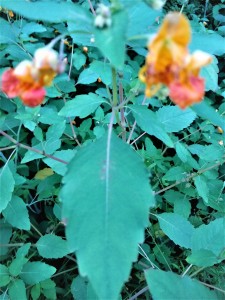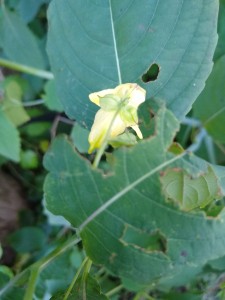 It has been a wet summer in my region and plants are lush and green. Lurking everywhere among that lushness is poison ivy, which is having a banner year.
It has been a wet summer in my region and plants are lush and green. Lurking everywhere among that lushness is poison ivy, which is having a banner year.
And, if that news is not enough to make you itchy, consider mosquitos, which also thrive in rainy, humid summer weather. The pesky insects, with their love of human and animal blood, are everywhere.
Fortunately, we all have a readily available arsenal of repellants and rash remedies at our disposal—or at least as close as the local drug store. But it is nice to remember that we also have jewelweed or Impatiens capensis, a North American native plant that costs nothing and can soothe the ravages of bug bites, not to mention the pain of skin assaults by poison ivy and stinging nettle. Ethnobotanists, homeopathic healers and nature lovers have touted jewelweed for years. Indigenous North American people used it long before most of our ancestors appeared in this part of the world.
If you have walked by a stream, pond, drainage ditch or damp woodland area in high summer, you have probably seen jewelweed. Also known as “touch-me-not”, orange balsam, spotted jewelweed or orange jewelweed, the plants bear small, orange flowers that are like bright little beacons amid other moisture-loving weeds.
These “jewels” are annuals, though they self-seed so readily that they might as well be perennial. The plants consist of smooth, succulent green to reddish green stems that can top out at between two and five feet tall, depending on growing conditions. Alternating on the stems, the blue-green leaves may be up to three inches long, with an ovoid in shape and toothed edges.
It would be relatively easy to miss jewelweed, were it not for the flowers, which are orange most of the time, but may also be pale yellow or nearly white. This year I have seen more yellow ones than usual, probably because the jewelweed population is so large and boisterous. No matter what the color, each flower is pendant, hanging from a short stalk that sprouts from the leaf axil, which is the place where the leaves and stem meet. The blooms are arranged in loose clusters.
Though the flowers are the most recognizable feature of jewelweed, almost no one takes a really close look at them. If you did so, you would see that they have five small petals apiece, arranged in upper and lower “lips”. Most petals are adorned with freckles or tiny spots, but some are unspotted.
When we leave nature alone, it often balances elements and that is the case with jewelweed, mosquitoes and poison ivy. All three favor damp environments, so when poison ivy and mosquitoes are thick, so is the jewelweed antidote to the troubles they cause.
I learned so much about wild plant identification and uses from my grandparents and parents that I am sure one of them taught me about jewelweed. I can’t remember who provided the lesson or when it was, but I feel as if I have always known that breaking open the stem and applying the sap to a mosquito bite will sooth the itch. Though the jewelweed liquid is not as thick as aloe, the application is much the same. For poison ivy, especially extensive rashes, it may be better to make a poultice of jewelweed leaves and apply it to the rash.
Some sources report that a tea made from jewelweed leaves steeped in water is a poison ivy rash preventive, but I have never heard of anyone actually ingesting such a brew. Still, jewelweed leaves contain the chemical compound lawsone, also found in greater quantities in henna, and well known for its usefulness as a dye. Lawsone reputedly also has antihistamine and anti-inflammatory properties.
Whether you use it for bites and rashes or not, jewelweed is an excellent pollinator and habitat plant. Its primary pollinator is the hummingbird, a welcome addition to any garden. Bees and butterflies will frequent patches of jewelweed as well. If you are considering a rain garden or native plant landscape for a consistently moist area, you may want to include jewelweed.
 Most people avoid getting lost in the woods, but it is nice to know that if you ever strayed from a beaten woodland path and into a mosquito swarm, jewelweed is there.
Most people avoid getting lost in the woods, but it is nice to know that if you ever strayed from a beaten woodland path and into a mosquito swarm, jewelweed is there.
